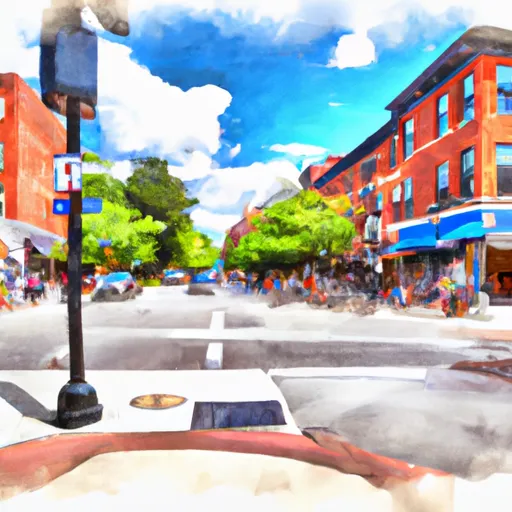-
 Snoflo Premium
Snoflo Premium
Get unlimited access to all our content
With no Ad interruptions! - Start Your Free Trial Login with existing account
Burlington
Eden Index
Climate
8.4
•
Recreation
4.2
•
Community
3.1
•
Safeguard
5.6/10

Burlington, Vermont is a vibrant city located on the shores of Lake Champlain, with a population of approximately 43,000 people. The city experiences a humid continental climate, with warm summers and cold winters. Due to its location, Burlington is susceptible to flooding from Lake Champlain and its tributaries. The city has implemented various measures to mitigate the impact of flooding, including the installation of flood walls and the restoration of wetlands. Outdoor recreation opportunities in Burlington include hiking, biking, and skiing in the nearby mountains, as well as water activities on Lake Champlain such as swimming, boating, and fishing. The city also has several parks and green spaces, including the popular Waterfront Park.
What is the Eden Index?
The Snoflo Eden Index serves as a comprehensive rating system for regions, evaluating their desirability through a holistic assessment of climate health, outdoor recreation opportunities, and natural disaster risk, acknowledging the profound impact of these factors on livability and well-being.
Climate Health Indicator (CHI): 8.4
Burlington receives approximately
903mm of rain per year,
with humidity levels near 76%
and air temperatures averaging around
8°C.
Burlington has a plant hardyness factor of
5, meaning
plants and agriculture in this region thrive during a short period during spring and early summer. Most
plants will die off during the colder winter months.
By considering the ideal temperature range, reliable water supplies, clean air, and stable seasonal rain or snowpacks, the Climate Health Indicator (CHI) underscores the significance of a healthy climate as the foundation for quality living.
A healthy climate is paramount for ensuring a high quality of life and livability in a region, fostering both physical well-being and environmental harmony. This can be characterized by ideal temperatures, reliable access to water supplies, clean air, and consistent seasonal rain or snowpacks.
Weather Forecast
Streamflow Conditions
Richelieu
Area Rivers
Richelieu
Snowpack Depths
Richelieu
Reservoir Storage Capacity
Richelieu
Groundwater Levels
Recreational Opportunity Index (ROI): 4.2
The Recreational Opportunity Index (ROI) recognizes the value of outdoor recreational options, such as parks, hiking trails, camping sites, and fishing spots, while acknowledging that climate plays a pivotal role in ensuring the comfort and consistency of these experiences.
Access to outdoor recreational opportunities, encompassing activities such as parks, hiking, camping, and fishing, is crucial for overall well-being, and the climate plays a pivotal role in enabling and enhancing these experiences, ensuring that individuals can engage in nature-based activities comfortably and consistently.
Camping Areas
| Campground | Campsites | Reservations | Toilets | Showers | Elevation |
|---|---|---|---|---|---|
| Mt. Philo State Park | 10 | 436 ft | |||
| North Beach | 137 | 163 ft | |||
| DAR State Park | 70 | 171 ft | |||
| Branbury State Park | 45 | 573 ft | |||
| Crown Point - DEC | None | 148 ft | |||
| Ausable Point - DEC | None | 116 ft | |||
| Burton Island | None | 126 ft | |||
| Button Bay State Park | 70 | 114 ft | |||
| Grand Isle State Park | None | 149 ft | |||
| Moosalamoo | 19 | 1,547 ft |
Nearby Fishing
Nearby Ski Areas
Catastrophe Safeguard Index (CSI):
The Catastrophe Safeguard Index (CSI) recognizes that natural disaster risk, encompassing floods, fires, hurricanes, and tornadoes, can drastically affect safety and the overall appeal of an area.
The level of natural disaster risk in a region significantly affects safety and the overall livability, with climate change amplifying these risks by potentially increasing the frequency and intensity of events like floods, fires, hurricanes, and tornadoes, thereby posing substantial challenges to community resilience and well-being.
Community Resilience Indicator (CRI): 3.1
The Community Resilience Indicator (CRI) recognizes that education, healthcare, and socioeconomics are crucial to the well-being of a region. The CRI acknowledges the profound impact of these elements on residents' overall quality of life. By evaluating educational resources, healthcare accessibility, and economic inclusivity, the index captures the essential aspects that contribute to a thriving community, fostering resident satisfaction, equity, and social cohesion.

